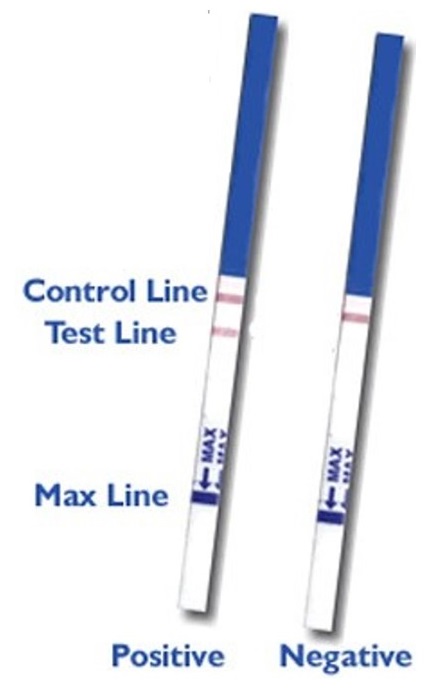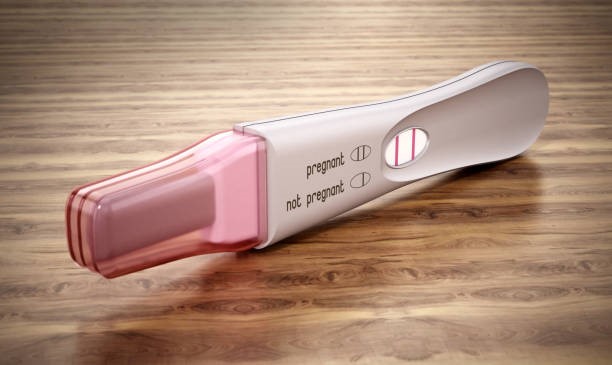By Chinedu Akpa. B. Pharm. Freelance Health Writer and DLHA Volunteer. Medical review and editorial support provided by The DLHA Team

A black woman holds a pregnancy test kit with her left hand, while she puts her right hand on her chin as she stares at the result
Whether it is a single or double line, the result of a pregnancy test is usually met with mixed emotions, but many people do not know how those results are obtained. This article aims to provide an answer to this and other questions about the use of pregnancy test kits.
Pregnancy and childbirth are so important to humanity's survival that some cultures have dedicated an entire deity to them. These deities are widespread across the African continent and they are believed to aid women conceive. They are generally referred to as fertility gods. However, the process of determining whether someone was pregnant or not took some time to standardize.
According to historical accounts, ancient Egyptians used barley and wheat seeds to determine a woman's pregnancy status. This procedure entails urinating on the seed of either of these two crops, and if the seeds sprout after a few days, the pregnancy is confirmed. Scientists later discovered that this process was 70% accurate, making it one of the first methods of detecting pregnancy. [1]
However, as time passed, scientific methods were developed to standardize the detection of pregnancy. The first of these methods was to perform a biological test on rabbits to detect pregnancy. This was the first method for measuring human chorionic gonadotropin (HCG) hormone (more on this later). [1] However, this method had the disadvantage of being time consuming, invasive (many people dislike the sight of blood), lacked privacy, and could endanger the animal's life.
These disadvantages prompted Margaret Crane to create the Predictor, the first homemade pregnancy test kit, in the late 1960s. The kit consisted of a test tube and a chemical solution. All the woman has to do is add a few drops of urine to the test tube, add some chemical solution, and shake the tube. A positive result will give a visible color change. [2]
Many people believe that a pregnancy test should be performed in the morning to get accurate results, but Promise Nwaejigh, a medical laboratory scientist at Mother and Child Hospital, says that a pregnancy test can be done at any time of day; however, doing so in the morning may increase sensitivity due to the high concentration of HCG in the urine at that time.
Morning tests appear to be the most popular, leaving many with questions such as; I wake up about twice to pee before the day begins; is that the right time to do it? Is that the first urine of the morning? It may be the first urine of the morning, but you are not required to use it as long as you do not drink a lot of water right before the test when you wake up. This is done to prevent urine dilution, which may affect the test's sensitivity.
Ovulation usually happens on the 14th day of each menstrual cycle. This assumes a regular cycle of 28 days. The egg's viability for fertilisation lasts 24 hours. If a sperm meets it at this point, fertilisation and conception occur (usually around the 15th day of your cycle). After fertilisation, implantation usually occurs within 7-10 days (days 22-27 of your menstrual cycle). During this time, your placenta develops and produces HCG, which is then released into your blood and, by extension, your urine, because HCG is not returned to the blood (reabsorbed) after kidney filtration.
According to the foregoing, you can check for pregnancy as early as day 22 of your menstrual cycle. However, most experts recommend that pregnancy tests be taken after the first day of your missed period. It should be noted that the sequence of events listed above may only occur during a regular menstrual cycle, which typically lasts 28 days.
We rarely question how a device works, especially when it is performing the function for which it was designed. However, there are always components that work behind the scenes to make a device function. In the case of a pregnancy test kit, the presence or absence of a substance known as human chorionic gonadotropin hormone (first hormone secreted during pregnancy), or HCG, determines whether a single or double line result is produced.
Ascheim and Zondek discovered it in 1927, and it has since become the most important hormone in determining pregnancy.
A pregnancy test kit works when HCG reacts with a protein known as an antibody. [3] This antibody is typically coated around the well of the kit where the urine is dropped, or in the case of a strip, a tiny hole (porous membrane) is created through which the urine passes to meet the HCG for a possible reaction. If HCG is present, a visible reaction occurs, such as a color change or a line.
Have you ever taken a pregnancy test and the result came back positive, but you waited months for your tummy to grow, only to be disappointed? This is known as a false positive result. Let us flip the table and look at it another way. Have you ever taken a pregnancy test and the result came back negative, and then you start noticing that your stomach is getting an inch bigger every week? Oh no, the test result was a false negative.
Certain factors can interfere with pregnancy tests, resulting in unexpected results. We have listed some of these factors below.
A false positive result occurs when a test incorrectly indicates the presence of a condition or substance when it is not actually present. In the context of a pregnancy test, a false positive result would mean that the test shows a positive result for pregnancy when the individual is not actually pregnant; while a false negative result is the opposite of false positive.
Causes of false positive urine pregnancy test results: [3]
Causes of false negative urine pregnancy test results: [3]
To avoid some of the common errors that interfere with pregnancy test results, caution must be exercised. One way to accomplish this is to read the manual instructions included with the test kit before performing it.
Pregnancy test kits come in a variety of shapes and sizes. Sometimes the choice of which one to use is based on convenience and ease of use. We have the strip, the midstream, and the cassette.

Labeled positive and negative pregnancy test strips.
The difference between the midstream and the cassette is that the midstream doesn't have a well or hole where urine is dropped, instead the pen-like mouth is streamed or dipped into a container of urine.

A midstream pregnancy kit is lying on its side, with two red lines visible on its readout screen.
This has two chambers, the smaller chamber or Well is used to collect urine in drops while the second chamber or screen is used to read the result.
A hand holds out a pregnancy kit cassette, with two red lines (control and test) showing on the screen.
This article explores the history and mechanics of pregnancy tests, from ancient Egyptian methods to modern kits. It discusses when and how to take a pregnancy test, factors that can affect results, and different types of test kits, such as strips, midstream, and cassettes.
1. National Institute of Health. The history of the pregnancy test. [internet,n.d] cited May 4th, 2024. Available from: https://www.livescience.com/37128-history-of-pregnancy-tests-ept-hcg.html.
2. National Museum of American History. Predictor Test-Design Prototype. [internet, n.d] cited May 4th, 2024. Available from: https://americanhistory.si.edu/collections/nmah_1803285.
3.Betz D, Fane K. Human Chorionic Gonadotropin. [Updated 2023 Aug 14]. In: StatPearls [Internet]. Treasure Island (FL): StatPearls Publishing; 2024 Jan-. Available from: https://www.ncbi.nlm.nih.gov/books/NBK532950/
Published: May 14, 2024
© 2024. Datelinehealth Africa Inc. All rights reserved.
Permission is given to copy, use and share content for non-commercial purposes without alteration or modification and subject to source attribution.
DATELINEHEALTH AFRICA INC., is a digital publisher for informational and educational purposes and does not offer personal medical care and advice. If you have a medical problem needing routine or emergency attention, call your doctor or local emergency services immediately, or visit the nearest emergency room or the nearest hospital. You should consult your professional healthcare provider before starting any nutrition, diet, exercise, fitness, medical or wellness program mentioned or referenced in the DatelinehealthAfrica website. Click here for more disclaimer notice.